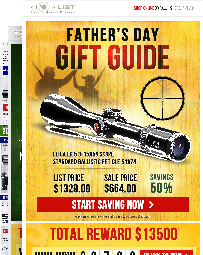Zeroing your riflescope is one of the most essential settings a shooter has to set correctly for aligning point of impact with point of aim. After you have known this basic concept, it seems simple. However, it’s not that simple and you need to look into it more closely.
Writing this article became important when many of our clients started asking about this concept. In fact, while interacting with them, we came to know the wide range of misconceptions people have regarding zeroing a scope. Some even asked for the right tool that will help them zero their riflescope. Yes, there are boresighters and other devices. However, they don’t help much when it comes to zeroing.
 Many people also inquired about scopes that don’t require zeroing. It should be reiterated here that no matter how sophisticated riflescope you are using, whether it is Nightforce Competition scope, Schmidt Bender PMII, Nightforce NXS, US Optics SN, Trijicon Accupoint, Swarovski Z6i, or Vortex Razor scope (HD), you have to zero your weapon properly.
Many people also inquired about scopes that don’t require zeroing. It should be reiterated here that no matter how sophisticated riflescope you are using, whether it is Nightforce Competition scope, Schmidt Bender PMII, Nightforce NXS, US Optics SN, Trijicon Accupoint, Swarovski Z6i, or Vortex Razor scope (HD), you have to zero your weapon properly.
However, it is better for a hunter or shooter to know the traditional way to zero a riflescope. However, before zeroing, you must know some basic concepts.
What’s the difference between Point of Impact and Point of Aim? Why Zeroing is Important?
Before going into the intricacies involved in the process, let us first explain what ‘point of impact’ and ‘point of aim’ means. Point of impact signifies the spot on the target where the bullet hits. However, point of aim is the exact place where you are targeting. When you are looking through a riflescope, point of aim is the point where reticle’s crosshairs intersect.
If a scope is not zeroed, the spot where the bullet hits will not converge with the spot that you had aimed. This means, if a riflescope is not zeroed, you will always miss the target. You will be aiming at one spot and the bullet will be hitting another, essentially not the one you aimed. That’s why zeroing is not only important but an essential step to ready a scope.
Why does Point of Impact and Point of Aim Differ? What Range of Shooting has to do with Zeroing?
If you have experience in shooting, you must know that bullet trajectory is not a straight line but an arc. This arc-type bullet path is formed due to gravitational pull of the earth, thereby creating a downward trajectory. The moment a bullet goes out of the barrel, gravity starts pulling it down no matter how much powerful cartridge you are using to fire the bullet. If the target is out of range of a rifle’s power, the bullet will hit the ground after losing momentum after a certain distance. Therefore, within a certain range of shooting, a shooter needs to zero his or her weapon so that point of aim converges with point of impact.
If you are shooting with .30-06 or .308, it is advisable to zero at a range of 100 meters or around 109 yards. It must be mentioned here that up to a distance of 500 yards, bullets more or less take a flat path. If distance of the target increases beyond that, especially when you are aiming at an animal during a hunt, you simply have to dial elevation turret to correct the elevation.
There are so many concepts and intricacies that a shooter or hunter should learn about zeroing a riflescope (say advanced riflescopes including Nightforce BEAST, Trijicon scopes, or Nightforce Competition) it is simply not possible to answer all the queries in a single article. In the first part of this three-article series, we have tried to give you a clear idea about the basic concept of zeroing, need of it, the scientific reason behind arc-type bullet trajectory, and need of zeroing within a certain shooting range.
In the coming two parts of this article series, we will delve with pre-zeroing at home, followed by zeroing at range.




Comments are closed.